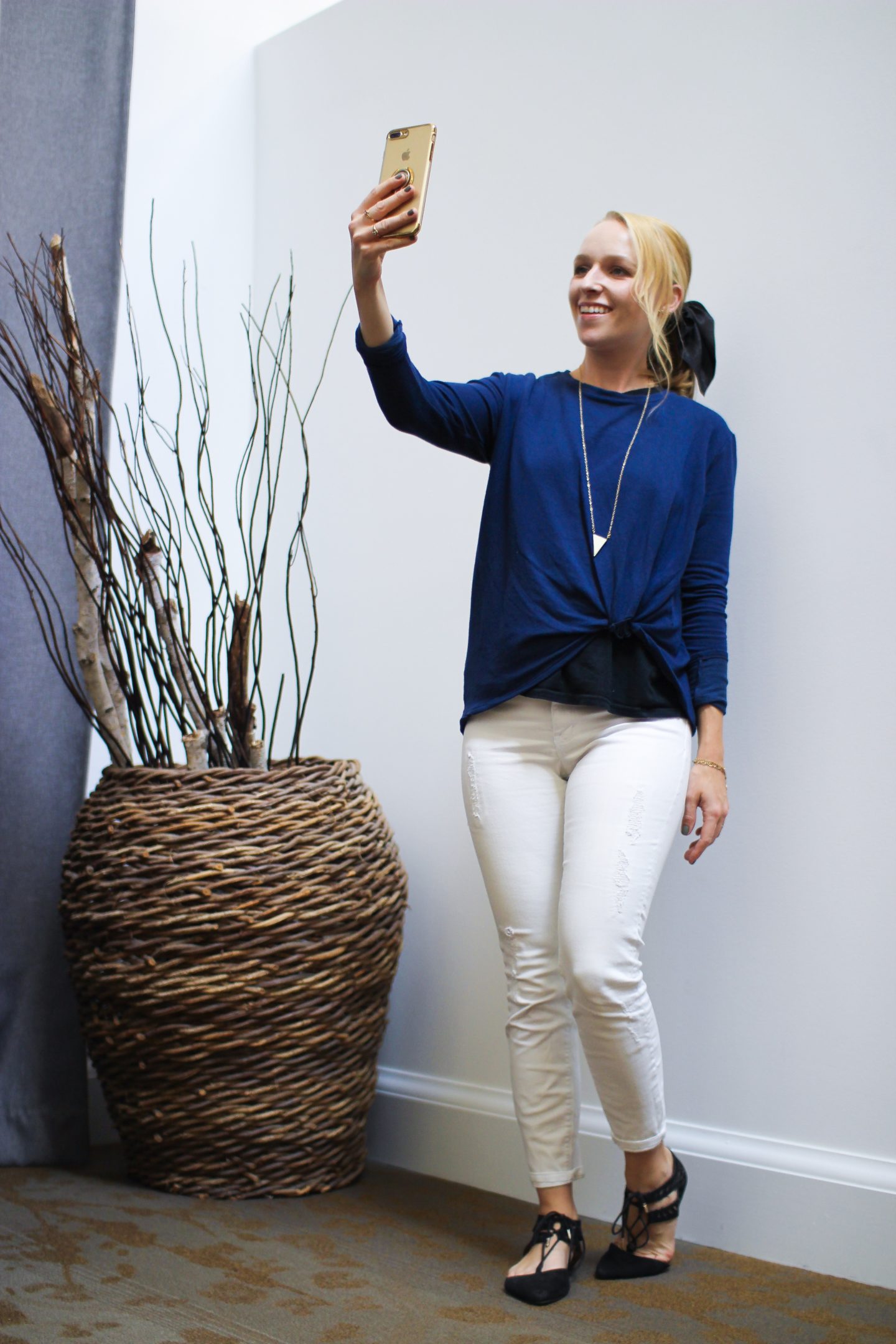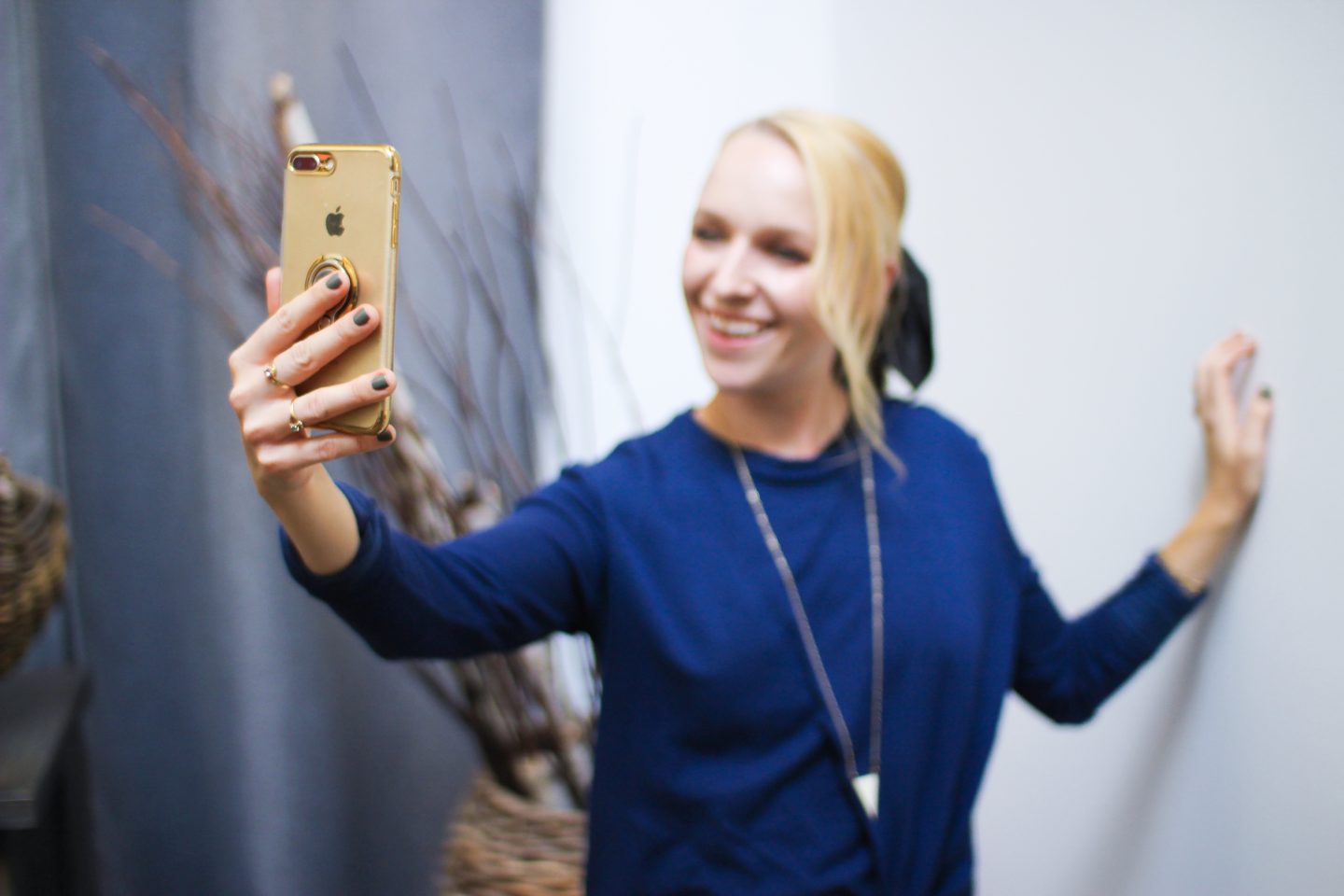Inspired by actual conversations with small business owners during social media consulting sessions as well as my own followers via Instagram.
Want to chat social media or working with influencers? Contact me or download my media kit to learn more.
Let me begin by saying that I don’t claim to be some kind of social media expert. However, social media is a huge part of the work that I do (see more of it here). Over my 5 years of blogging, I have amassed a total following of almost 30k across my social media networks. Truth be told, my business is dependent on it. One of the first stats brands inquire about when they consider working with me is how large my reach and audience is. A significant amount of traffic to this blog arrives here via social media. So, to say that my social media presence is insignificant would be inaccurate.
But this isn’t just true for me. Social media does matter. How many followers you have matters. How engaged they are matters. The quality of your content matters and developing trust with your audience is of the utmost importance. If you think social media isn’t an integral part of your marketing plan, then this post isn’t for you. I’ve had to learn how to grow, maintain and develop my social media accounts because it is essential to my success and I’m willing to bet that it is for your brand too.

How Do You Know What Works and What Doesn’t?
Over the years I’ve had the opportunity to manage and produce content for small businesses, have been responsible for this professionally in my previous job (before I was full-time changing diapers) and currently offer consulting services to business owners.
So ya, I talk about this a lot. I’ve answered so many questions about everything social media. I’ve seen plenty of good, and not so good social media practices. How do I know what works and what doesn’t? Well, I’ve made a lot of my own mistakes! I’ve tried and failed more times than I can count. But, I’ve also found success and learned about what works if your goal is to grow your brand, develop an online presence, and utilize social media to sustain your business.
If you’re doing any of the things I’m about to mention, don’t take offense. Feel free to disagree with me! These are of course my personal opinions and I’m still learning every day. But, if these are indeed your social media practices, I’d consider changing your ways.
Here are 5 social media mistakes and some advice about how you can improve your social game going forward.
1) Sharing Too Many Personal Details
This is a sticky one because I’ll often hear people say “well, I want to share the person behind the product” or “I want people to realize that I am real and struggle in the same way everyone does”. I get that, and the intention behind the overshare is good, but that doesn’t make it appropriate for your business account.
Listen, no one wants to hear about all of your problems on your Instagram Story. Can you share your struggles and how you’ve overcome them? Sure. That’s inspiring and may be helpful for someone who can relate to it. But if you’ve posted 10 videos in a row going on and on as the makeup runs down your face, consider what value you’re bringing to those watching. And, I’m sorry to break it to you, but no one cares to watch you make french press coffee on Saturday morning. Why would they? Is watching coffee pour into a cup in a boomerang loop something we’ve never seen before?
Consider the value of what you’re bringing to your audience. No one cares to watch you pour french press coffee on Saturday morning. #sorrynotsorry
How do you Determine What to Share?
Ask yourself why people watch your videos and engage with your content. WHY is the big question here. Before hitting send, or share, take a pause and ask why.
Why do followers choose to engage with your content? Is it because they use your products or services? Is it because they want to see how they’re made or want to be made aware of new offerings? Do they want to learn a new skill? Is it for entertainment purposes? To laugh? Maybe their lives look similar. Maybe they too have kids, or also live where you do and gain a sense of familiarity when they see life through your eyes. If it doesn’t add value to your followers by filling a void, answering a question, or providing information that is going to make their lives fuller and easier, then don’t share it.
And if you’re just dying to share your kid’s class photo on your social media account, then I urge you to go ahead and make a personal one. Because if those following you aren’t doing so to gain children’s fashion inspiration, perhaps it’s best that this content is shared elsewhere. Ya feel me?
If it doesn’t add value to your followers by filling a void, answering a question, or providing information that is going to make their lives fuller and easier, then don’t share it.
2) Using the Wrong Social Media Platforms
So you think your business has to have an Instagram account because everyone has one. Or you don’t use Pinterest because you don’t know how to and you’re not good at DIY. Neither of these reasons is solid in their reasoning when it comes to choosing which social media platforms to invest your time in. In order to decide which platform is right for you and your business, you need to have a good understanding of who your audience is and which platforms they are using so you can meet them where they are.
Each platform comes with its strengths and weaknesses when it comes to how content is digested by consumers and the demographic that uses it. Depending on your product and business, it may make sense to have various social media accounts, or just one or two. In actuality, there are dozens of social media platforms, but unless you’re employing a full team you won’t have the bandwidth to properly devote the time to more than 3 or 4 at most. So you need to have a good understanding of who your target audience is, where to find them, and how to engage them.
Which Platform is Appropriate for my Business?
Really, it’s as simple as understanding the following: your target audience, the strengths and weaknesses of the different social media platforms and who uses them. Once you have a solid understanding of this, you can see how it all aligns.
Know your audience: Create a profile for your ideal target audience. Seriously, like an imaginary made-up person. You can even make it fun and draw a picture and give them a name. What I’m saying here is that you should know who they are and have an image of them in your mind’s eye to reference when you’re creating content. Because you’re creating it for them! Where do they live? What challenges do they face? What are their demographic details? With this information, you can better determine where they are online. It will help you decide which social media platform to use. If you need some help creating this profile, this article has some key questions you can answer to help you paint a picture.
Know your social: Similarly, you need to understand who uses each social media platform. What age group? What is their education level? What income bracket? Once you know who uses what platform and which of those people are your audience, it’s pretty easy to assess which social media accounts you should devote your time to. This article details the stats for each social platform so you can play matchy-matchy.
Choose the right social platform by asking yourself: Where is my target audience online and what kind of content would best engage them?
Lastly, consider how your content should vary depending on the platform you are using to ensure that it’s going to engage users. For example, Instagram isn’t the place for images that look like ads, that’s more likely to perform well on LinkedIn. If you’ve got a lot to say, or you want to share a lengthy video, Twitter isn’t going to work. Utilize the strengths of each social media platform accordingly and post where your audience already is and will see it. It may take some experimentation to get it right, so pay attention to your analytics and adjust accordingly.
3) Not Linking From Social Media to Your Own Website
You may be wondering why I’m touching on website ownership when this blog post is about social media. Well, that’s because social media is a marketing tool that creates a funnel of interest in your product whether that product is you/your service, or something you sell/make. Funnels channel attention elsewhere, a.k.a. to your website. Social media is the middle man, it’s where you find the people so you can lead them where you want them to ultimately go. This place should be your website because this is the only space on the internet where you are the owner and are in full control. Even if it’s not an entire website, even if it’s just a contact me/email me page on your work’s website. That’s fine! The goal here is to drive your followers there to elicit your services.
Social media is there to amplify your message and brand like a loudspeaker. To draw attention to your work and lead people to its home (your website).
But, Can’t I Just Host All of My Work on Social Media?
Maybe you remember Vine? The social media platform that featured short video clips and one day just disappeared? Well, I’m sure the users who had huge followings on Vine (and only there) we’re distraught when one day poof, all of their content evaporated into thin air. This won’t happen when you have your own website. Your work won’t just dematerialize unless you want it to. It’s in your control. Your success and the success of your brand is not dependent on anyone but yourself.
Does that mean that you can’t have content that you create specifically for social media or for a certain platform? No, you can and should tailor your content to ensure maximum community engagement. But your work and brand shouldn’t die when and if a social media platform does. Social media is there to amplify your message and brand like a loudspeaker. To draw attention to your work and lead people to its home (your website). Use it to its maximum potential to do this!
If that social platform were to disappear tomorrow, would your brand die with it? Having your own website ensures that you have ownership and control over your content.

How Do I Get Followers to my Website?
Always be sure to link to your website via your social media accounts. Use the link in bio on Instagram and change it regularly to send followers directly to your most recent work. I like to write something like “shop my look” or “check out my latest post” in my description to direct attention to this. Tweet links to your website with a sentence describing what readers will find there. Link to your website content from your Facebook account regularly. Make a Pinterest graphic on Canva and upload a new pin. But whatever you do, don’t use some third party link service such as Linktree. Here’s why.
Don’t Use Third-Party Services Such as Linktree
You’ve probably seen quite a few people using this service, but I’m here to caution you against it. I learned the hard way when I got banned from linking to this blog from Facebook and Instagram for weeks as a result of using Linktree.
You can imagine just how detrimental this was for my business. Every single Facebook post I had EVER created that linked to my blog was blacked out, I couldn’t use swipe up links in my Instagram Stories, and I could even include my URL in a direct message.
Never again! It took me weeks to get this resolved. Don’t do it. Make sure your homepage leads users to the content they will be looking for or create your own original social media landing page with links. Here’s what my social media links landing page looks like. You can also find a great example and step-by-step of this here. It’s a great idea to make one of these because this way you can control the look and feel of the landing page with your own branding, followers are easily directed to your site (which helps with Google rankings), and they can find what they’re looking for within seconds.

4) You’re Not Varying Your Content
By this I mean all you ever post are photos of the same thing: your product with flat lays at different angles, shots of your work (which to you may look diverse but to the average follower just look repetitive) or photos of yourself in the same room in the same pose. Newsflash, it’s boring!
You have about .5 nanoseconds to make an impression on a potential new follower when they are scanning your content and deciding whether or not you’re worth following. Many may not read a single word you’ve written in any of your captions. You’ve got to give the could-be-follower a reason to dive deeper and gain an interest in you and what you have to offer.
The beauty of social media is the ability to play, create, and experiment. If it turns out truly heinous and you’re waking up in a cold sweat at 2am you can always delete it (felt cute, might delete later).
What Else Should I Create and Share?
The beauty of social media is the ability to play, create, and experiment. What have you got to lose?! If it turns out truly heinous and you’re waking up in a cold sweat at 2am you can always delete it (felt cute, might delete later). Use the opportunity to learn something from it. What’s important here is that you tried something new and different. In many instances, I’m willing to bet that this will perform better than your usual fare because of that reason alone (new content, who dis?). And in the off chance that it doesn’t, at least you added a new skill to your social media bag of tricks that you can continue to improve upon.
Instead of scratching your head and overthinking why your account may not be growing or why your engagement is decreasing (the algorithms on social media are tough) challenge yourself to try something new. I made my first video on social media because photos weren’t getting as much engagement as they used to. I made my first GIF and infographic for the same reason. I had no idea if anyone would like or engage with this content. But I tried it anyway.
Another mistake a lot of business owners make is that they only use social media to post their content, but they never engage with anyone else’s and don’t see what else is out there. Get inspired by your competition! Find some accounts that you love. What is it about their content that inspires you? What do they do that you aspire to? Make that your creative goal (but remember, Rome wasn’t built with one Tweet). Google some how-to instructions, download some free apps, make a GIF, or create a video. If you’re still stuck you can always contact me and we can do it together!

5) You’re Not Leveraging Your Network
Every social media platform has built-in tools to help you maximize the potential reach of your post. You can tag other accounts on the image and in the caption. You can use the @ symbol to tag businesses, people, and other accounts. All too often I see posts where this isn’t done and I sit there and wonder why oh why didn’t they use the magical tag tool? What a missed opportunity!
How do you feel when you get a notification? The same way we all feel when we are acknowledged in the big wide world of the interweb. Like we’re not just one in a billion.
Why Should You Tag Other Accounts in your Content?
Tagging other accounts is one of the most powerful yet underappreciated social media tools of them all. Here’s what happens when you use the tag tool.
The tagged account receives this thrilling little alert referred to as a notification. How do you feel when you get a notification? Because the person running the account in question feels the same way. They open up Instagram and the little heart icon is lit up because something has happened while they were away. They get excited, they feel popular, they feel important. Thanks, little heart icon, you’ve got my attention. And then they see it, they see that you’ve tagged them because you visited their restaurant, because they’re in your photo, because their product is mentioned in your caption. And how do they feel? The same way we all feel when we are acknowledged in the big wide world of the interweb. Like we’re not just one in a billion.
And what do they do with this feeling? They act on it! They may repost it on their account, they may add it in their Instagram Story, they may share it with their friends on Facebook or their network on LinkedIn. And there you have it, all of a sudden the reach of your post has increased exponentially. Suddenly you’ve leveraged this simple tool to increase the likelihood that your post is engaged with by more people allowing them to discover your work and hopefully follow you. All because of that often underused little “at” symbol.
Tagging other accounts is one of the most powerful yet underappreciated social media tools of them all.
When Shouldn’t You Tag Other Accounts?
Now, of course, it goes without saying that you shouldn’t abuse the tag tool because this is a no-no and will have the opposite effect. Don’t tag people or accounts that aren’t directly included in your content. If someone isn’t actually in the photo, don’t tag them. Don’t misuse the comment section of your post and tag everyone who follows you just so they look at your post. Because you know what? They will, and they’ll see that you used and abused the special tag tool for non-special purposes and feel annoyed with you. And like me, they may purposely (and admittedly sometimes quite spitefully) not engage with your content despite your efforts.
Do not abuse the special tag tool for non-special purposes. It may cause others to feel annoyed and behave spitefully towards you.
Other Questions You Asked Me via Instagram Stories:
Over on Instagram, I opened up the floor to my followers to find out what questions you had about social media – anything at all! Here’s what you sent my way along with my responses.
Thank you to everyone who shared their thoughts with me!
- If a company just sends me a product but I’m not being paid to post about it, do I have to disclose this? Yes. You should always disclose if you have been gifted a product or are sponsored in any capacity what so ever. If you got it for free, received a discount, or if you got anything of value you should disclose this. For all the particulars about this use the FTC regulations as your guide.

- I’m starting a new business and I can’t decide if I should do a funky spelling to make it original or not. What should I consider? You want to think of a name that’s original, but not so out there that no one will know how to spell it in an online search. Keep the spelling simple. Before you settle on a name Google whether or not it’s already taken and search social media to see if the handle you’d like is already in use. Ideally, your handle is the same across social media accounts and your website will eventually rank in an online search. You don’t want too much competition to be found easily because others have the same/a similar name.
- How do I get my posts seen by more people? Not only should you use the @ symbol as mentioned above when appropriate, always use hashtags and location tags. In your Stories and in your posts. You can hide them under text or a GIF if you don’t like the look of it (which is what I do), but using these will only increase the chances that your content is seen by an interested audience.
- I always see brands working with other people or sharing their content but never me! How do I get them to notice me? Have you reached out and asked? I reach out to brands and/or ask them to share my content all the time. When I first started blogging I would work cross-promotion into each agreement as a way of helping me with exposure. If you want to work with a company, send an email with your pitch and media kit (you can download mine here if you want to see what one looks like). Follow up. Send another email with your links after the fact. What’s the worst that can happen? That they’ll ignore you? So what!? Give it a try. You never know.
- If I create a post should I use the built-in tools to have it auto-share to other social platforms like Twitter and Facebook for me? The content can be the same, but it should be tailored to each platform. For example, it can be tempting to let Instagram auto Tweet for you, but this won’t display your content in the most engaging way possible (it will just display a link, not the image). Upload to each manually and customize it for the platform and the audience you hope to reach there (ie. make a graphic on Canva, a shortened video for Twitter, an Insta Story to go along with your post on Instagram). If you don’t have time to upload manually, consider investing in a management tool such as Sprout Social or the like. But, you should only share content on the platforms you regularly use. If all you ever do on Twitter is put up your own photos (ie. you never engage in conversation or reply to other people’s Tweets because you don’t have time) then consider whether you should have that social media platform at all.
Disclosure and transparancy with your audience is of the upmost importance. If you recieved anything of value from the brand you should disclose this. And not because they told you to, but because it’s the ethical thing to do.
- How often should I post on social media? On Instagram specifically? You should post as much as humanly possible. I’m kidding. But ideally, you’re posting every day. That’s hard I know, and it’s not something I’m able to personally keep up with. But, know that posting regularly (and daily) with good quality content will help you grow and will get your content seen. The algorithms like it. Think of it this way, the social media app Gods want you on their platforms as much as possible. They want you to be on there all the time! However, think about quality vs. quantity too. It’s better to post quality content than post something subpar or uninspired just because you think you should. Consistency is key, so if you can’t manage an editorial schedule that involves posting every day, don’t. Just post consistently, and when you’re not posting your own content, engage with others by liking, commenting, or joining in the conversation.

- How much should I spend on an Instagram or Facebook ad to make it perform well?
I have never in my life spent more than $12 to boost a post. Seriously. Don’t think about it as more money equals more success. That’s not the case. I know the previously mentioned app Gods will disagree with me, but they, of course, want your money!
You don’t have to spend a lot on your post as long as you target it really well. Run an ad for only a few days at a time so you have a chance to digest the analytics and reassess if necessary. Instagram and Facebook know so much about their users it’s scary, but as an advertiser, this is advantageous. For example, if you’re hoping to find people interested in hair care and beauty products, narrow in on those people by age range, location, and similar interests (such as makeup, skincare, etc). Don’t concern yourself with how much money you’re spending, that isn’t necessarily going to make your ad any better. Do some research on your target market. Dedicate the time to tailoring your ad and narrowing in on the people you want it to reach.
- How do I become an influencer?
When did I become one? Lol. I’m honestly not sure I even like that title, but I’m referred to that way so I go with it. I’d say if your entire goal is to be an influencer than you’re probably already doing yourself a disservice. Sorry but it’s true! Your motivations will be pretty transparent. If you’re expecting free stuff, big paycheques, and working in your sweatpants from home I’m here to tell you that ain’t real.
Think about what you can uniquely offer an audience, what kind of community you want to create. What are you passionate about that you want to share? What story do you want to tell? What value can you provide? Focus on creating. On building relationships. On improving your ability to provide engaging and relatable content. If your focus is on getting free stuff, you’re going to be disappointed and probably won’t last long. Over the years so many people have told me they’re starting a blog and I see that they are no longer doing it. It’s hard to keep it up for as long as it takes to taste a morsel of success. I never expected to become an influencer. I just wanted to write and hoped someone would read it. When I started this wasn’t really a “job” and I didn’t get paid for my work for years. I think this is true of many successful full-time bloggers and influencers. Manage your motivations and expectations first and foremost, work hard and the rest will follow.

If you take only one thing away from this post, let it be the following. Trust is the most valuable currency on social media. Not followers, not likes, not comments. Developing a rapport and trust with your audience is priority number one! Don’t expect to develop it over a matter of weeks or months. It takes years! You will not build a large social following overnight. You will not develop website traffic because of a handful of posts. It will take a lot of work, a daily commitment, and a lot of creativity. But, as social media know-how has become a staple in the world of digital marketing, it’s worth the hustle.
Anna
Do need help creating content? Need to start your social media accounts but have no idea where to start? Want someone to brainstorm creative social media ideas with or take content photos together? I’m your girl! Shoot me an email and let’s chat about how we can creatively collaborate.
If you’re more comfortable checking out my work first, you can download my media kit and click lots of links on my Work With Me page.



